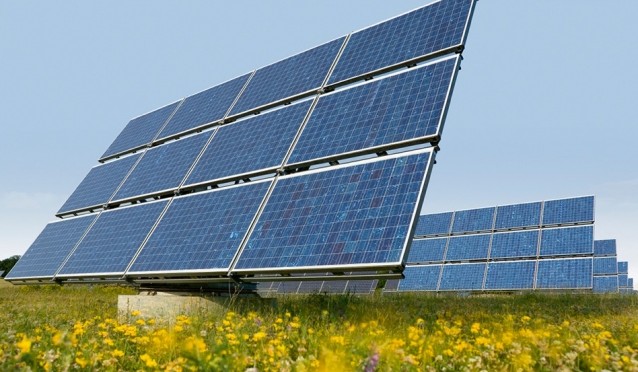Solar power capacity is growing around the world. But new studies, including one from the MIT Energy Initiative, suggest it isn’t growing quickly enough to meet the world’s expanding energy needs and stall the threat of climate change.
The world’s power mix is shifting from emissions-heavy fossil fuels to cleaner sources like solar, wind, and hydropower. Among US renewables, solar is the fastest growing, according to the US Energy Information Agency, and along with wind it accounts for almost two-thirds of renewable growth.
But despite all the progress that has been made, there is still concern that a global energy transition is not happening fast enough to stave off the worst effects of climate change. Two studies out this week suggest that while a cleaner energy future is within reach, it is by no means preordained.
“The past decade has been a remarkable time for the solar industry. Last year up to a third of all new generation capacity in the US was solar,” says Francis O’Sullivan, director of research and analysis at MIT’s Energy Initiative. “However, continued rapid growth in solar is not an inevitability.”
In the US, solar faces expiring tax credits, difficult grid integration, and a dearth of support for basic research, experts say. Globally, solar growth – and expansion of renewables more broadly – isn’t enough to mitigate global warming, according to a report released Monday by the International Energy Agency in Paris. Governments need to triple spending on clean energy research and development, IEA says, if the world hopes to limit warming to 2 degree Celsius, the internationally agreed-upon goal.
“The stakes are high for the energy sector, but it is also no stranger to profound technological change,” IEA Executive Director Maria van der Hoeven said in a statement Monday. “Today’s annual government spending on energy research and development is estimated to be USD 17 billion. Tripling this level, as we recommend, requires governments and the private sector to work closely together and shift their focus to low-carbon technologies.”
In December diplomats meet in Paris to broker a global deal limiting emissions. But even if an emissions-cutting pact is reached, it will require a tremendous effort to simultaneously expand energy access while developing the technology to make that energy cleaner.
“Coupled with projected growth in energy demand is the urgent need to deal with climate change,” Robert Armstrong, director of MIT’s Energy Initiative, said Wednesday at an event in Washington rolling out a report on the future of solar energy. “Those are the dual challenges we face: Double energy supply to the world, and remove carbon from the system.”
Solar will help fill in the gaps left by fossil fuels in a clean energy future, so much of the research and development IEA prescribes would go toward solar power.
Unlike other energy sources, solar can be deployed anywhere – atop residential rooftops, in backyards, on office buildings, and in utility-scale systems. As Vox’s David Roberts points out, solar panels have another major advantage: They convert sunlight directly into electricity, whereas gas and nuclear power plants have to spin turbines to generate power. That means that, once installed, solar panels produce relatively low-maintenance, pollution-free electricity.
And while solar and wind power are ready for primetime and capable of competing with traditional sources in some circumstances, weaknesses remain. According to the IEA report, “for very high deployment levels of wind and [solar] PV, innovation is needed in demand-side integration, energy storage and smart grid infrastructure.”
Energy storage, for one, got a high profile boost last week when Tesla CEO Elon Musk announced his company would make batteries for storing electricity in homes, businesses, and power plants.
Batteries could enable homeowners and utilities to more easily capture and store power from intermittent sources like the wind and the sun – a major development, since the Achilles’ heal of wind and solar has long been that their power isn’t available at night or on windless days.
Still, Tesla’s new battery isn’t a silver bullet, and it remains to be seen if consumers flock to energy storage like many hope they do.
“Despite the Tesla announcement, we’re not there yet. We’re not close to being there yet” when it comes to storage, Richard Schmalensee, chair of MIT’s Future of Solar Energy study, said Wednesday.
There’s hope that government research could help, according to the MIT and IEA reports.
Download
- Full Report
- Executive Summary
- Foreword and Acknowledgments
- Chapter 1 – Introduction and Overview
- Section II – Solar Technology
- Chapter 2 – Photovoltaic Technology
- Chapter 3 – Concentrated Solar Power Technology
- Section III – Business/Economics
- Chapter 4 – Solar PV Installations
- Chapter 5 – Economics of Solar Energy Generation
- Section IV – Scaling and Integration
- Chapter 6 – PV Scaling and Materials Use
- Chapter 7 – Integration of Distributed Photovoltaic Generators
- Chapter 8 – Integration of Solar Generation in Wholesale Electricity Markets
- Section V – Public Policy
- Chapter 9 – Subsidizing Solar Technology Deployment
- Chapter 10 – Advancing Solar Technologies: Research, Development, and Demonstration
- Appendix A – The Solar Resource
- Appendix B – Photovoltaics Primer
- Appendix C – Energy Storage Systems for the Electric Power Sector
- Appendix D – Concentrated Solar Power Models and Assumptions
- Appendix E – Methods and Assumptions Used in Chapter 5
- Appendix F – Background Material for Chapter 8
- Study Participants and Advisory Committee
- Acronyms and Abbreviations


